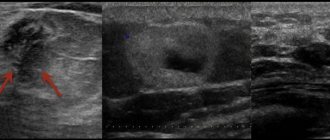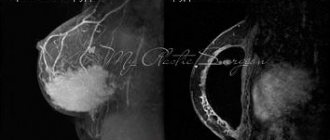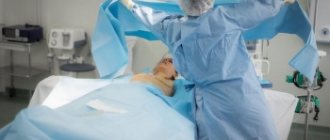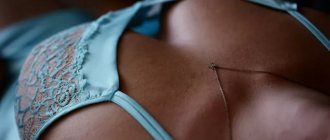Loss of sensitivity and numbness of the nipples or other areas of the skin of the mammary glands is a fairly common complication that develops after breast augmentation surgery.
If numbness in the lower part of the gland, where soft tissues are more injured, is a natural and temporary phenomenon, then a decrease in the sensitivity of the nipple-areolar complex is an undesirable and not planned phenomenon. It is difficult to say in what percentage of cases such a complication occurs since there is not a lot of reliable statistical data. It is believed that persistent impairment of the sensitivity of the areola and nipple occurs in 2-10% of cases of all operations performed.
The following manifestations of sensory impairment occur:
Hyposthesia -
This is a sensitivity disorder that is characterized by decreased sensitivity in the area of the nipple and areola, as well as in the lower part of the gland. As a rule, it is temporary and occurs naturally in the first days and weeks after surgery. Gradually, the area of reduced sensitivity decreases and completely disappears by one year after surgery.
Hypostesthesia of the nipple-areolar complex is rarely irreversible. In some cases, with very thin soft breast tissue, hypoesthesia in the lower pole of the mammary gland can be permanent, but this, unfortunately, is a cost of the operation.
Hyperesthesia -
This is a sensitivity disorder that is characterized by increased sensitivity in the area of the nipple and areola. A characteristic feature of this type of disorder is the intensification of normal sensations, sometimes to the point of pain.
Often patients note that the sensations when touched remain the same, but their intensity has increased significantly. Hyperesthesia is most often a temporary phenomenon. The presence of hyperesthesia indicates that there is no significant damage to the nerve endings and sensitivity will soon return to normal.
Paresthesia -
These are special sensitivity disorders that are characterized by atypical manifestations of sensitivity. These include “pins and needles”, tingling, as well as any other manifestations of sensitivity atypical for this area. Another special feature is that these sensations are in no way related to external influences.
As a rule, parasthesia to one degree or another occurs in many patients after surgery, but passes quickly enough. Most often, such sensitivity disorders are associated with overstretching and compression of nerve endings.
Anesthesia -
This is the most severe of all types of sensitivity disorder, which is characterized by a complete lack of sensitivity in a certain area of the mammary gland. This disorder is associated with complete damage to the branches of the sensory nerves innervating this area.
Anesthesia is an extremely rare complication, since damage to all branches innervating the mammary gland during cosmetic surgery seems unlikely. However, the branches of the fourth intercostal nerve make a very significant contribution to the innervation of the nipple-areola complex and their damage can significantly impair the sensitivity of the areola and nipple.
Speaking about impaired sensitivity, it is necessary to evaluate this complication from a practical point of view, namely from the point of view of patients, how much the decrease in sensitivity affects the quality of life. In my experience, a year after surgery, it is extremely rare for anyone who has undergone surgery to complain of discomfort from decreased sensitivity.
Even if, with the help of a targeted survey, it is possible to find out that there is still a decrease in sensitivity, it turns out to be minimal and in 90% of cases in the area of the scar, which is quite natural and expected. The main thing is that very rarely does anyone complain that this interferes with their lives.
Causes of loss of sensitivity after mammoplasty
There are several reasons why sensitivity is impaired, but their essence comes down to damage to nerve fibers and nerve endings. This damage can be either reversible or irreversible. Let's look at the main ones.
1. Damage to nerve fibers. Any surgical operation is accompanied by incisions, separation and movement of tissue. During the operation, damage to nerve fibers is inevitable. This is fine. The surgeon must have a good knowledge of the anatomy in order not to damage large branches of the nerves during the operation, since their damage can lead to a permanent decrease in sensitivity. Over time, small nerve fibers and nerve endings are restored and sensitivity gradually returns.
2. Damage to the fourth intercostal nerve. The fourth intercostal nerve is known to be responsible for the sensitivity of the nipple and areola.
This nerve passes at the level of the midaxillary line. Branching into two parts, it runs along the circumference of the chest and enters the gland tissue.
During the operation, the surgeon must remember that there is a possibility of damage to this nerve, so the operation in this area must be performed very carefully.
Complete or partial damage to the anterolateral or anteromedial branch of this nerve sometimes still occurs. The result of this can be a sharp decrease in the sensitivity of the nipple-areolar complex, which can be permanent.
3. Large implant size. Installing an implant that is too large can also affect the sensitivity of the skin of the mammary glands or nipples, as well as numbness after surgery. This is explained by the fact that an incorrectly selected, very large implant size exerts strong pressure and stretches the fourth intercostal nerve, which is squeezed between the implant and the chest.
Most often, this is manifested by stabbing and pulling pain, but these pains are rarely permanent and go away within a few weeks.
3. Implant location. During observations, it was revealed that when installing an implant under the pectoralis major muscle, the risk of sensitivity and numbness is less than when installing under the mammary gland.
It must be remembered that even in the case of a perfectly performed breast enlargement operation, the sensitivity of the nipples may be impaired. The explanation for this, as mentioned above, is the greater sensitivity of the skin of the nipples, due to the large number of nerve endings.
The nerve endings that connect to the nipple are very small and thin, and very often the surgeon, without noticing, stretches or cauterizes them during surgery.
If the nerve fibers were stretched during surgery, their sensitivity is restored fairly quickly. If they are cauterized, it will take a longer time for them to recover, depending on the degree of their damage.
What you need to know before surgery
- During the first 2-3 weeks after mammoplasty, 80% of women experience numbness in the mammary glands. This is due to swelling, which puts pressure on the nerve fibers.
- The body's reaction to the introduction of an endoprosthesis can be expressed both in loss of sensitivity and in its aggravation.
- The percentage of women who have lost breast sensation after breast augmentation during primary intervention is low.
- Much more often, the brightness of sensations remains at the same level or increases due to the pressure of the implant.
- If there is a change in sensitivity, you should contact the operating doctor. Part of the skin may become numb due to the scar forming. Timely measures taken will save you from unnecessary problems.
- There are many ways to restore the previous erogenous activity of the site.
Satisfaction with breast reduction surgery: expectations and results
Imagine for a moment that it's been a year since your breast reduction surgery.
Was it worth doing?
Do you look and feel as expected?
In this article, I will tell you what to do to ensure that your results meet your expectations as much as possible.
Plastic surgeons have noticed for decades how happy patients are after breast reduction surgery, even though these women are left with scars on their breasts.
The reason for this high level of satisfaction is that the surgery relieves numerous debilitating symptoms and improves the overall health of each patient.
Numerous recent scientific studies have proven that this surgery results in predictable long-term improvements.
Breast reduction surgery can also provide direct and indirect economic benefits to both patients and their employers.
Symptoms
When researchers analyzed the results of the BRAVO study, in which they surveyed hundreds of women, they were surprised to find that women with symptomatic breast enlargement were experiencing far more pain than doctors had ever realized.
What's not surprising is that their research has finally provided a wealth of medical evidence that breast reduction surgery helps women relieve many symptoms, including:
- backache
- pain in the neck
- shoulder pain
- headache
- pain and numbness in the arms and hands
- skin irritation and rash
- dyspnea
Diana: “I don’t have that nagging back pain that I had every single day. I sleep much more comfortably. This is incredible. I just feel so good."
Tatiana: “I used to have migraines at least once or twice a week. I haven’t had a single headache since the surgery (surgery 1 year ago).”
Olga: “Everything is gone. Back pain, shoulder pain, numbness in arms. Last summer there were no rashes. The surgery was the best thing I've ever done for myself."
Most women experience significant or complete relief from various types of pain and numbness. Skin rashes and irritation are usually completely eliminated. The woman may feel less short of breath. In fact, you will be one of the rare patients if you do not experience significant or complete relief from many of your physical complaints.
The study results also showed that the improvement in symptoms experienced by patients after breast reduction was independent of their body shape, body weight, bra cup size, or the amount of breast tissue removed during surgery.
In other words, if you are overweight, breast reduction surgery will benefit you just as much as a non-overweight woman.
If your symptoms are severe and your breasts are larger than average but not huge, removing a relatively small amount of breast weight can be just as beneficial as removing more weight from another woman's breasts.
Research has confirmed that improvement in symptoms after breast reduction surgery lasts for many years, regardless of whether the woman's weight changes. In fact, even if you gain weight after surgery, you probably won't have to go back to a larger bra size.
When researchers took a closer look at the symptoms experienced by women with heavy breasts, they found that women who had breast reduction surgery not only felt better compared to how they felt before surgery, but actually felt as good or even better. better than a group of women the same age who didn't have heavy breasts!
Physical effects
With smaller and lighter breasts, the upper body can function more easily.
After surgery you should notice:
- Improved posture
- Increased muscle strength in the back and shoulders
- Improved lung function
Angelica: “I don’t slouch anymore! It’s incredible that this heavy burden has finally been lifted from my shoulders.”
Tatyana: “Finally, it became easier for me to breathe. It's hard to breathe when you have two watermelons on your chest."
Your posture and muscle strength have long been compromised and will not return to normal overnight. However, most disorders not associated with an uncorrected anatomical abnormality (eg, scoliosis) are reversible.
If you need more help or if you find that your shifted center of gravity is causing new pain, ask your surgeon to prescribe physical therapy. A short course of physical therapy usually helps.
Shoulder hollows are one of the few physical consequences of excess breast weight that can be permanent, especially in older patients who have had to walk around with heavy breasts for many years.
Pulmonary function is rarely impaired in healthy women with large breasts, but even so, testing after breast reduction surgery often shows improved respiratory function. Even without formal testing, you may notice this improvement simply by feeling less shortness of breath.
Your breasts
Immediately after surgery, your breasts may have an odd shape. By four months her shape will begin to look more natural, and by six to nine months her shape will be fairly stable.
After a year, you probably won't notice any significant changes in breast size or shape unless you have a major change in hormone levels, such as those seen during pregnancy, menopause, or hormone therapy.
If you are under eighteen years old and your breast size has not stabilized in the year or two before surgery, you may experience further breast enlargement.
One of the plastic surgeon's goals during breast reduction surgery is to achieve a breast shape that will ultimately (one year after surgery) have an improved shape.
As a patient, you hope for a beautiful and natural breast shape. The way your breasts will look after surgery is determined by the unique characteristics of your breasts (initial data) before surgery, the chosen surgical technique, and the presence of any complications during the healing process.
In general, after surgery you can expect:
- The chest will be tightened.
- Quite symmetrical breast size, shape and position of nipples and areolas.
- The chest will be approximately the same width as before surgery.
- There will be anchor scars on the chest.
Breast reduction surgery corrects significant asymmetry in breast volume.
Ideal symmetry of breast shape, nipple size and position is impossible for several reasons.
- First, no woman can be perfectly symmetrical before surgery, and the causes of asymmetry may not lie in the mammary glands themselves. No woman has symmetrical structures of the shoulder girdle and chest. Muscles, bones, joints and all associated joints may be significantly more developed on one side and not developed on the other.
- Second, plastic surgeons can only weigh what they remove during surgery, not what they leave behind, and must visually (while the patient is still under anesthesia on the operating table) assess whether the patient's breasts are sufficiently symmetrical.
When complications develop after breast reduction surgery (such as bleeding, infection, fat necrosis, etc.), they often affect only one breast. The occurrence of a complication can lead to long-term, although not necessarily severe, breast asymmetry.
Among the many factors that influence the final shape of your breasts, a few that you and your surgeon have no control over are skin type and elasticity and genetically determined healing characteristics.
You may also have limited control over any underlying medical conditions.
Surgeons select surgical techniques that they are most comfortable with and that they believe will be most suitable for their patients. Experienced surgeons have a better understanding of the intricacies of this operation than beginners or those who perform it infrequently, but no surgeon can guarantee perfection of the form.
Nipple/areola color, contour and sensitivity
For most women who undergo breast reduction surgery, the nipple-areolar complex is moved to a new, higher position on a feeding vascular pedicle.
With this type of surgery, if there are no problems with healing, the color of the nipple and areola remains unchanged. The areola size is usually made smaller than the original and has a more rounded shape.
Nipple sensitivity after surgery may be unchanged, decreased or increased. Many women with large breasts do not care about nipple and areola sensitivity, but some are very concerned that the possible loss of nipple and areola sensitivity may reduce the erotic pleasure they receive from their breasts.
All reduction mammoplasty techniques remove tissue that may contain nerve fibers that supply the nipples and areolas, and some patients experience partial or complete loss of NAS sensation on one or both sides. Some sensation may return over time, but the extent and timing of improvement cannot be predicted.
For unknown reasons, some women may experience increased sensitivity of the SAH after surgery. For any given patient, it is impossible to predict how much her SAH sensitivity may change after surgery.
Patients who underwent free nipple plastic surgery during surgery will lose almost 100% sensitivity and erection of the nipples, and the pigmentation of the nipples and areolas may also change. Pigmentation changes are especially noticeable in patients with dark skin, in whom SAH may appear pink or patchy.
In some patients, the color of the SAH returns within the first year or more after surgery. Mottling may be the result of incomplete return of pigmentation.
An alternative is to perform a permanent SAC tattoo.
Nipple inversion is not usually corrected during breast reduction surgery to minimize disruption of the blood supply to the nipple. Nipples that are too large can be safely reduced later.
Scars
Naturally, you would prefer not to have scars after surgery, but the vast majority of women are indifferent to the presence of scars on their breasts.
Over time, the scars will smooth out and turn white; Scars may also expand. Scar expansion is more common in patients prone to stretch marks.
Keloid scars are of particular concern to women. Most often, keloids develop during the first few months after surgery. Fortunately, they are very rare in breast reduction surgery and are extremely unlikely to develop in a patient without a history of keloids.
Problematic scars—hypertrophic scars and keloids—are discussed in more detail in the complications article.
Breast-feeding
A small number of women who have breast reduction remain able to breastfeed.
But it is also a known fact that a significant number of women with large breasts who have never had breast surgery are unable to breastfeed for various reasons.
In women who undergo a free SAH graft for a breast reduction, milk will be produced postpartum, but the patient will not be able to breastfeed because all of her milk ducts have been cut. As with all postpartum women who do not breastfeed, milk production will cease and any milk produced will be absorbed by the breast itself. It is also possible to take drugs that suppress lactation.
I always recommend that my patients undergo breast reduction surgery after their last planned birth.
Mammography
Regular mammograms (breast x-rays) should be part of every woman's medical examination to maximize the chances of early detection of breast cancer.
Breast reduction surgery results in changes that are visible on a mammogram, including altered breast contour, distortion of the internal architecture of the breast, scarring, fat necrosis, asymmetrical lumps, and the late appearance of coarse microcalcifications (calcium deposits).
With the exception of calcification, these signs are usually most noticeable in the first hours after surgery and improve over time. Calcifications, on the other hand, are often not visible until the second or third year after surgery. However, coarse calcifications are the most common type of calcification and not the type of calcium deposits often seen in breast cancer.
I recommend that women delay getting a mammogram after breast reduction surgery for about a year, even if she "should" have one sooner.
The breasts can be sore for quite a long time after surgery, and the kind of compression that is necessary to get a good mammogram can be quite painful if done early in the recovery period.
When you are ready to have your first mammogram after surgery, make sure the radiologist taking the x-ray knows that you have breast reduction surgery.
Psychological results
In addition to physical relief, patients after breast reduction surgery also feel better psychologically.
It has been repeatedly confirmed that after surgery, women's self-esteem increases dramatically. Even if your weight has not changed much, patients visually become slimmer and thinner.
Your outlook on life will become more optimistic. You will be ready to travel and try things you never dreamed of before your surgery. You will look forward to social events much more than in the past.
Tina: “This operation changed my life. My self-esteem has increased. I am very happy. I am very grateful to you, doctor.”
Natalya: “Finally, I look harmonious. Before, even when I was thin, my top was at least two sizes too big for my pants, so I could never buy two-piece outfits or dresses.”
Julia: “I never bought new shirts when I was pregnant, since I already had huge ones to cover my breasts. I couldn’t wait to throw these things away.”
Marina: “I always felt awkward in restaurants because my chest stuck out too much. While eating food, I leaned forward and stretched my neck so that the food did not drip onto my protruding chest. Even after the surgery, I still ate like that because I developed a habit.”
Irina: “I was sad when I was eight and a half months pregnant and no one noticed it because my breasts were so big. Now I feel that my form is normal"
Activity level
Women who have breast reduction surgery often experience a dramatic increase in their overall activity level.
Suddenly, they can do their jobs better and complete tasks faster, including housework and other chores that they simply couldn't handle before surgery.
Mothers and grandmothers love the opportunity to play games with their children and grandchildren. These women have increased exercise tolerance and more energy for all activities, leading to even greater participation.
An impressive result of the research was that before surgery, almost all women were unable to play sports, whereas after surgery, almost all began to play sports.
It is now a generally accepted fact that people can improve their health and life expectancy simply by increasing their activity levels.
Alevtina: “The operation changed my life. This is the best decision I've ever made. My knees don't hurt, my back pain is gone, and I don't get out of breath when walking. I like to walk! Thanks to you, doctor, I have a second chance to make my life longer and healthier."
The quality of life
Breast reduction surgery can save you a lot of daily frustration.
For example:
- Studies have shown that women who have had surgery are much less likely to use medications such as painkillers, anti-inflammatory drugs and muscle relaxants.
- You can also remove the medicated creams you have been using to treat the rashes under and between your breasts. Once your breasts no longer rest on your upper abdomen, you won't have the combination of moisture and lack of air circulation that allows bacteria and yeast to grow in your breast folds. If you don't have to wear underwire bras, you'll be completely free of chronic irritation under your breasts, even in warm weather.
- You can go shopping! After breast reduction surgery, nothing gives a patient more pleasure than going to the store and buying bras.
- You can improve your love life. Of course, this is a complex issue, but in medical studies, a third of women reported improvement in intimate relationships and very few (less than 5%) reported a deterioration.
Economic benefit
It is very difficult to measure changes in productivity among the diverse group of women who participated in the study, but each person knows how the surgery affected her life and work performance.
It seems clear that a woman suffering from back and neck pain is less likely to apply for a high-paying job that requires heavy lifting or other strenuous physical activity. Oddly enough, many women have told me how much easier their work became after surgery.
Numbness on the left and right sides of the body: what are the differences?
Numbness of the right arm or leg, simultaneous or sequential, occurs with osteochondrosis, scoliosis, herniated intervertebral discs, when the blood supply to tissues and the conductivity of nerve endings are disrupted. If this syndrome was preceded by a sensitive acute headache or injury, the cause may be much more serious - a stroke or a brain tumor.
When a sensitivity disorder is observed on the left side of the body, a person feels a tingling sensation, and the motor functions of the limbs suffer. If at the same time the facial muscles go numb, blood pressure rises, and dizziness appears, this suggests an ischemic or hemorrhagic stroke or serious pathologies of cerebral circulation. Therefore, numbness on the left is considered a more dangerous symptom than on the right.










